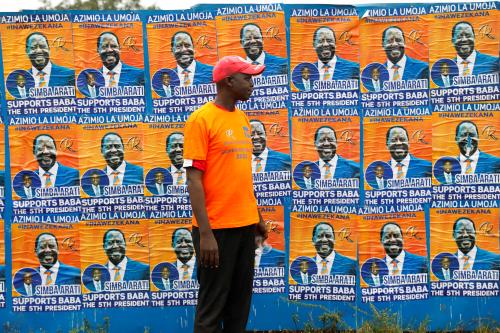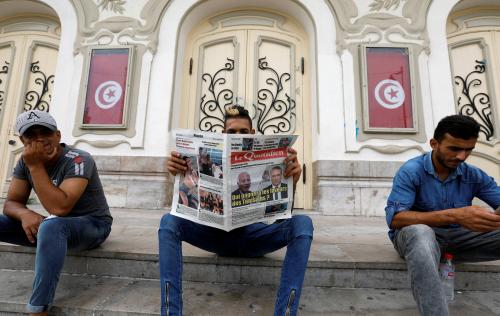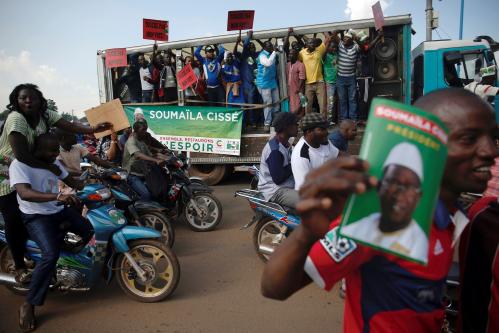It was reported on October 10 that Raila Odinga withdrew his candidacy for Kenya’s presidential election, which will likely throw the October 26 vote into considerable doubt. Below, experts analyze, among other things, the broad state of Kenya’s judiciary and governing institutions, which are challenges that remain salient in spite of how the specific electoral process plays out.
Following Kenya’s August 8 elections, after which incumbent President Uhuru Kenyatta claimed victory, the country’s supreme court declared the result invalid. A tentative re-run of the presidential portion of the election is now scheduled for October 26. It will occur as debates over the judiciary’s proper role in politics and a number of other issues—including when and how to reform the independent electoral and boundaries commission—remain heated.
On October 2, the Africa Security Initiative of the Foreign Policy program at Brookings hosted an event focused on Kenya’s uncertain political path. Panelists included Matt Carotenuto of St. Lawrence University, Lauren Ploch Blanchard from the Congressional Research Service, and John Tomaszewski of the International Republican Institute. Michael O’Hanlon, Brookings senior fellow, moderated the discussion.
Although the election was voided, O’Hanlon pointed out that: “[T]here’s been some concern and some violence even today around these demonstrations, [but] it’s nothing like what happened 10 years ago, when more 1,000 people died in violence after disputed presidential elections.”
Matt Carotenuto also offered historical context, reminding the audience that “2017 is the 60th anniversary of Kenya’s independent history.” And for much of that period, “Kenya was ruled by one political party. From 1969 to 1991, it was, in fact, a one-party state,” he noted.
Violence has been a part of Kenya’s electoral history, but it has not been equally serious at all times. Elections in 1992, 1997, and 2007 were marred by violence. Elections in 2002, 2013, and this year have not had the same issues, although there has been some loss of life.
Carotenuto reflected on the fact that this was only the second election since the adoption of a new constitution in 2010. He pointed out that the two contestants—Uhuru Kenyatta and Raila Odinga—are well-known figures in Kenyan politics. So, despite the uncertainty surrounding the election, Kenyans remain on fairly normal ground, with both candidates having coalitions across the country.
The vote itself was peaceful, but as usual in Kenya, “the concerns are around pre and post-election issues,” said Carotenuto.
Discrepancies in tallies and an inability to verify ballot counts ultimately led the supreme court to annul the results. This was in the midst of some protests and violence, including reports of several dozen killed, perhaps at the hands of state police.
John Tomaszewski was quick to point out that the results “did have the incumbent President Kenyatta winning, with 54 percent of the vote, to Odinga’s 45 [percent].” Further, he shared that a domestic election observing group conducted a parallel tabulation which corroborated the results.
In this sense, the ruling party’s insistence that the results stand carries some weight. Speaking about the supreme court decision, Tomaszewski pointed out the view of the dissenting judges. To paraphrase: While there may have been process problems with the results transmission, overall if you look at the forms, the president won the vote, and that should stand.
The division in the courts has caused rhetoric to grow more heated, concluded Tomaszewski. He noted that on the one hand, President Kenyatta has said he accepts the decision to hold a new election; on the other, Kenyatta has been calling the justices “wakora” (which more or less means crooks and robbers) at rallies.
Tomaszewski indicated that he expects “we’ll be looking at some serious electoral changes to law” in the time ahead.
Lauren Ploch Blanchard formally observed the August 8 election in Kenya. She noted that, as with most such election observation efforts, observers are only able to monitor those procedures they are present for. They cannot certify an election as free and fair based on a short stay in the country.
Questions are swirling, internally and externally, around the decision of the election commission and its future. Odinga has called for its replacement; the ruling party has called for changes to the way the body is led. In other words, there are dueling ideas about how to reform, and disagreement as well as to whether a new vote should happen before the matter is resolved.
As Kenya moves toward a new vote, other outstanding questions include whether or not similar issues of internet connectivity will plague the redo—about one-quarter of the votes in the first attempt could not be transmitted for tabulation. Blanchard highlighted that there was no test of the mobile communication network prior to the first election, and there has not been one since.
There are also questions about voter registration. “The number of voters announced registered in June, when the register was declared final, differed from the number of voters announced when the commission announced the results,” Blanchard stated.
Without critical changes before the new vote, Blanchard wondered what might happen if it is redone and the supreme court comes to similar conclusions. “We could be in a cycle of this happening again and again and again.”
Blanchard did point out that she thought authorities in Kenya handled election day well. While Blanchard expressed confidence in the initial process, she also pointed to growing uncertainty in many sectors, and wondered how people might react to the next election redo if it ends with similar problems. She expressed hopefulness, however, that at least compared with many other African states, peaceful and legal mechanisms for protest and for challenging the process exist.
O’Hanlon, stating he was both “worried and impressed” by Kenya’s response to the election, asked the panelists what we should expect on October 26.
Carotenuto pointed out that Kenyans he has spoken with are appreciative of the supreme court’s actions, “even if they didn’t necessarily agree with the decision.” While the confusion is troubling, he also feels it is a positive that Kenyans are largely looking to the constitutional institutions for answers, instead of the street.
Agreeing with Carotenuto, Blanchard argued that the 2010 constitution is critical. “There were some very important changes put in place under the 2010 constitution that brought us such a long way from where we were in 2007.” She believes violence has been lower in great part because the opposition feels it does have recourse, which was not the case in the past.
Tomaszewski concurred on the importance of the 2010 constitution in the lack of violence seen today. “Keep in mind that Kenya is a young democracy, and this is a sausage making process,” he said. Tomaszewski called the 2010 constitution an “amazing victory” for the people of Kenya, and stated it was the strongest on the continent.
Good or bad, he believes we should take away that Kenya’s judiciary has teeth and can get things done. “This is something we should be happy about, it has value,” he went on to state.
While Tomaszewski feels that it will be very hard for Odinga to win in the runoff, he closed on a hopeful note about the country’s institutional depth and resilience.
“We should be very optimistic,” he said, “devolution has diluted political power at the top and moved it to the ground.” He pointed to active local governments and business, arguing that these sectors are essential for keeping the country moving.






Commentary
How Kenya is handling uncertainty as it heads toward a presidential election redo
October 10, 2017